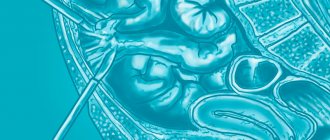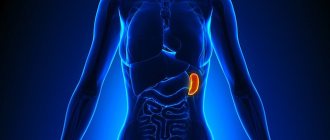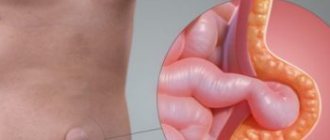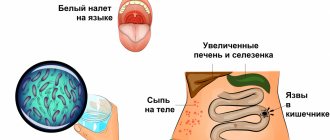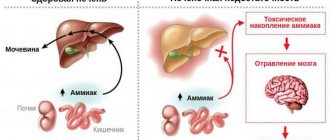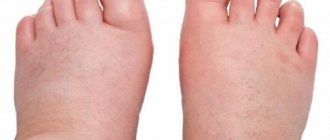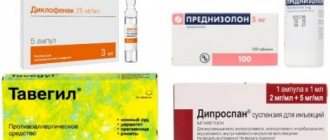Abdominal ascites - symptoms and treatment options, prognosis for life
Ascites (abdominal dropsy) is a condition characterized by the accumulation of free fluid in the abdominal cavity (more than 25 ml), which can be either inflammatory (exudate) or non-inflammatory (transudate). The disease is manifested by an increase in abdominal circumference, difficulty breathing, pain in the peritoneum, a feeling of heaviness and distension.
Most often (in 80% of cases) ascites occurs against the background of liver cirrhosis, which has reached the final stage of decompensation. This stage is characterized by depletion of liver resources, serious disturbances of the hepatic and abdominal circulation, that is, the emergence of favorable conditions for the accumulation of fluid.
Causes
The causes of ascitic disease are unexpected, the most common among them are presented below. This:
- malignant neoplasms and metastases;
- liver cirrhosis and increased blood pressure in the portal system;
- thrombosis (narrowing of the hepatic, inferior vena cava and portal veins);
- acute and chronic inflammatory kidney diseases;
- nephrotic syndrome (protein begins to be excreted in the urine);
- chronic renal failure;
- inflammatory lesion of the serous membrane of the heart;
- acute and chronic heart failure;
- some infectious and inflammatory bowel diseases, in which diarrhea and protein loss are observed;
- inflammation of the pancreas;
- tuberculosis;
- pseudomyxoma (mucus accumulation);
- anasrka.
This disease is a complication of liver cirrhosis and more. It progresses gradually in the body; at first it does not manifest itself in any way. Abdominal ascites is difficult to treat successfully. However, healing occurs if the main pathogenic factor is eliminated.
Symptoms of ascites
The formation of abdominal ascites in most patients with cancer occurs gradually, over several weeks or even months. Therefore, the first signs of this formidable complication remain unattended.
Clinically, ascites begins to manifest itself after a sufficiently large amount of fluid has accumulated in the abdominal cavity; this complication manifests itself:
- Feeling of fullness in the stomach.
- Abdominal pain of different nature and duration.
- Belching and heartburn.
- Nausea.
You can visually pay attention to the gradually increasing belly; in a vertical position it hangs down, and in a horizontal position it spreads out to the sides. Stretching the skin of the abdominal wall allows you to see the network of blood vessels and the protruding navel.
Pressure on the chest causes shortness of breath and irregular heart function. With ascites, it is difficult for a person to bend over, fasten shoes, or put on trousers.
Reasons for development
Ascites is a serious complication of stomach and colon cancer, colorectal cancer, malignant tumors of the pancreas, and oncological pathology of the mammary glands, ovaries and uterus. When a large volume of fluid accumulates in the abdominal cavity, intra-abdominal pressure increases, and the diaphragm moves into the chest cavity. This leads to disruption of the heart and lungs. There is a violation of blood circulation in the vessels.
In the presence of ascites, the patient's body loses a large amount of protein. Metabolism is disrupted, heart failure and other imbalances in the internal environment of the body develop, which worsen the course of the underlying disease.
There is always a small amount of fluid in the abdominal cavity of a healthy person. It prevents the sheets of peritoneum from sticking together. The produced intra-abdominal fluid is reabsorbed by the peritoneum.
With the development of cancer, the normal functioning of the body is disrupted. The secretory, resorptive and barrier functions of the peritoneal layers fail. In this case, either excess fluid production or disruption of its absorption processes may be observed. As a result, a large volume of exudate accumulates in the abdominal cavity. It can reach twenty liters.
The main reason for damage to the peritoneum by malignant cells is its close contact with organs that are affected by a cancerous tumor. Ascites in the presence of oncological pathology develops under the influence of the following factors:
- A large accumulation of blood and lymphatic vessels in the peritoneum through which cancer cells spread;
- Tight fit of the folds of the peritoneum to each other, which contributes to the rapid spread of malignant cells to adjacent tissues;
- Germination of a cancerous tumor through the peritoneal tissue;
- Transfer of atypical cells to peritoneal tissue during surgery.
Chemotherapy may be the cause of ascites. The accumulation of fluid in the peritoneum occurs due to cancer intoxication. If the liver is affected by a primary cancerous tumor, metastases of malignant cells from tumors of a different location, the outflow of blood through its venous system is disrupted, and portal hypertension develops - an increase in pressure inside the portal vein. The lumen of the venous vessels increases, plasma sweats from them and accumulates in the abdominal cavity.
The cause of ascites may be peritoneal carcinomatosis. In the presence of a cancerous tumor of the abdominal organs, atypical cells settle on the parietal and visceral sheets of the peritoneum. They block the resorptive function, as a result of which the lymphatic vessels do not cope well with the intended load, and lymph outflow is impaired. Free fluid gradually accumulates in the abdominal cavity. This is the mechanism of development of carcinomatous ascites.
Make an appointment
Stages
Depending on the amount of accumulated exudate, three stages of ascites are distinguished:
| Transitory | fluid in the abdominal cavity no more than 400 ml. At this stage there may only be bloating. |
| Moderate | is set when there is no more than 5 liters of exudate in the abdominal cavity. At this stage, the complication manifests itself with clinical symptoms in the form of disruption of the digestive organs and shortness of breath. If ascites is not treated, peritonitis, respiratory and heart failure may develop. |
| Tense | characterized by the accumulation of up to 20 liters of liquid. The patient's condition is serious, the functioning of vital organs is significantly impaired. |
Diagnostics
Hydrocele of the abdomen can be diagnosed by a doctor even without the use of special equipment - it is enough to palpate the patient’s abdominal cavity. If, upon palpation, the doctor detects dullness in the abdomen on the side, while tympanitis is found in the middle, the patient has ascites.
To carry out a more in-depth diagnosis, it is necessary to perform an ultrasound in the peritoneal cavity, examine the liver, and also perform a puncture of the peritoneum (paracentesis). Taking the fluid for analysis allows us to identify the stage of the disease and determine its treatment. Paracentesis is performed to determine the causes of the disease. Paracentesis can also be done if there is difficulty breathing or pain.
In addition to the above diagnostic methods, the patient must undergo urine and blood tests, as well as undergo immunological studies. The possibility of prescribing additional analyzes and tests depends on how much information the obtained tests provide the doctor.
What will the patient face after the diagnosis is confirmed?
If an ultrasound confirmed ascites, the course of the treatment process will directly depend on the cause that caused the accumulation of excess fluid in the abdominal cavity. To make an accurate and reliable diagnosis, the doctor will prescribe additional diagnostics. The patient undergoes:
- general clinical and biochemical analysis of urine and blood;
- research on tumor markers and electrolyte metabolism;
- general x-ray of the abdominal and thoracic cavity;
- coagulogram showing the level of functionality of the blood clotting system;
- vascular angiography;
- CT and MRI of the peritoneum;
- hepatoscintigraphy, which will make it possible to view the liver with a special gamma camera;
- laparoscopy together with puncture of ascitic water may also be required.
If the patient has liver cirrhosis, he will additionally need to undergo portosystemic intrahepatic shunting. The manipulation is carried out using a mesh metal stent. The stent affects the space between the hepatic and collar veins. If an advanced form of the disease is observed, then organ transplantation is indispensable.
Treatment of abdominal ascites
Abdominal ascites, which develops as a complication of cancer, should be treated together with the underlying disease.
- It is also important to begin eliminating excess fluid in the first two weeks of its formation, since delaying therapy leads to the development of a host of complications. Excess fluid can be removed by puncture and pumping it out - laparocentesis, by taking diuretics.
- Following a special diet will help reduce intra-abdominal pressure and reduce the likelihood of further production of excessive exudate.
Chemotherapy is effective only if ascites is caused by intestinal cancer. For cancer of the stomach, ovaries and uterus, the use of chemotherapy does not give a significant positive result.
Forecast
Ascites in cancer significantly worsens the general well-being of the patient. As a rule, such a complication occurs in the later stages of oncology, in which the survival prognosis depends on the nature of the tumor itself and its distribution throughout the body.
Life expectancy with ascites depends on the following factors:
- Functioning of the kidneys and liver;
- Activities of the cardiovascular system;
- The effectiveness of therapy for the underlying disease.
The development of ascites can be prevented by an experienced doctor observing the patient. Doctors at the Yusupov Hospital have extensive experience in dealing with various types of cancer. Qualified medical personnel and the latest equipment allow for accurate diagnosis and high-quality, effective treatment in accordance with European standards.
Drug treatment
The main drugs that help remove excess fluid from the body are diuretics. Thanks to their intake, it is possible to achieve the transition of excess fluid from the abdominal cavity into the bloodstream, which helps reduce the symptoms of ascites.
- To begin with, patients are prescribed the smallest dose of diuretics to minimize the risk of side effects. An important principle of treatment with diuretics is a slow increase in diuresis, which will not lead to significant losses of potassium and other important metabolites. The most commonly recommended medications are Aldactone, Veroshpiron, Triamterene, and Amiloride. In parallel, potassium supplements are prescribed. At the same time, hepatoprotectors are introduced into the treatment regimen.
- At the same time, doctors monitor the patient’s diuresis on a daily basis and, if treatment is ineffective, increase the dose of drugs or replace them with stronger drugs, for example, Triampur or Dichlorothiazide.
In addition to diuretics, patients are prescribed drugs aimed at strengthening the walls of blood vessels (vitamin C, vitamin P, Diosmin), drugs that prevent fluid from leaving the vascular bed (Reopoliglucin). The introduction of protein preparations improves the metabolism of liver cells. Most often, concentrated plasma or an Albumin solution in a 20% concentration is used for this purpose.
Antibacterial drugs are prescribed if ascites is bacterial in nature.
Treatment
Drug therapy for ascites is not carried out due to low effectiveness. Aldosterone antagonists and diuretics normalize water-salt metabolism and prevent excess secretion of peritoneal fluid. Oncologists at the Yusupov Hospital offer palliative surgery to patients with ascites in the late stages of cancer:
- Omentohepatophrenopexy;
- Deperitonization;
- Installation of a peritoneovenous shunt.
Doctors at the Oncology Clinic carry out traditional or intracavitary chemotherapy for ascites - after removing the fluid, a chemotherapy drug is injected into the abdominal cavity. Laparocentesis is performed to remove fluid. The procedure is not performed if the following contraindications are present:
- Adhesive process inside the abdominal cavity;
- Severe flatulence;
- Perforation of the intestinal walls;
- Purulent infectious processes.
Laparocentesis is prescribed in cases where taking diuretics does not lead to a positive result. The procedure is also indicated for resistant ascites.
Laparocentesis is carried out in several stages using local anesthesia:
- the patient is in a sitting position, the doctor treats the subsequent puncture site with an antiseptic and administers painkillers;
- An incision is made in the abdominal wall along the linea alba at a distance of 2-3 centimeters below the navel;
- The puncture itself is performed using a trocar using rotational movements. A special flexible tube is attached to the trocar, through which excess fluid is removed from the body. The fluid is pumped out quite slowly, and the doctor constantly monitors the patient’s condition. As the exudate is removed, the nurse tightens the patient's abdomen with a sheet to slowly reduce the pressure in the abdominal cavity;
- After the fluid is pumped out, a sterile bandage is applied to the wound.
Using laparocentesis, up to 10 liters of fluid can be removed from the patient’s body. In this case, it may be necessary to administer albumin and other drugs to prevent the development of renal failure.
If necessary, temporary catheters can be installed in the abdominal cavity, through which excess fluid will gradually be removed. It should be noted that the use of catheters can lead to a decrease in blood pressure and the formation of adhesions.
There are also contraindications to laparocentesis. Among them:
- pronounced flatulence;
- adhesive disease of the abdominal organs;
- stage of recovery after surgery on a ventral hernia.
Diuretics are prescribed to patients with developing ascites in cancer over a long course. Such drugs as Furosemide, Diacarb and Veroshpiron are effective.
When taking diuretics, medications containing potassium must also be prescribed. Otherwise, there is a high probability of developing disturbances in water and electrolyte metabolism.
Dietary nutrition primarily involves reducing the amount of salt consumed, which retains fluid in the body. It is also important to limit the amount of fluid you drink. It is recommended to include more foods containing potassium in your diet.
After removal of fluid from the abdominal cavity, patients are provided with a balanced and high-calorie diet. This allows you to meet the body's needs for proteins, carbohydrates, vitamins and minerals. Fat consumption is reduced.
Abdominal laparocentesis
For ascites, abdominal laparocentesis is a surgical procedure in which fluid is removed from the abdominal cavity by puncture. You should not pump out more than 4 liters of exudate at a time, as this threatens the development of collapse.
The more often a puncture is performed for ascites, the higher the risk of developing peritoneal inflammation. In addition, the likelihood of formation of adhesions and complications from the procedure increases. Therefore, for massive ascites, it is preferable to install a catheter.
Indications for laparocentesis are tense and refractory ascites. The liquid can be pumped out using a catheter, or it simply flows freely into a previously prepared container after the trocar is installed in the abdominal cavity.
What is ascites and why is it dangerous?
The content of the article
The abdominal cavity is a separate anatomical region. It systematically produces moisture necessary to increase the efficiency of sliding of the abdominal visceral layers. During normal activities, the resulting effusion is absorbed fairly quickly.
However, it happens that free fluid begins to collect in the abdominal area. The cause of this anomaly may be a failure of blood circulation and lymphatic drainage or the presence of inflammatory processes. This disease is called “ascites,” which is better known as “dropsy.”
Dropsy of the abdomen is difficult to treat and leads to serious health problems. After all, the fluid accumulated in the peritoneal area creates ideal conditions for the formation of pathogenic microflora. It includes the causative agents of such dangerous diseases: hepatorenal syndrome, peritonitis, umbilical hernia, hepatic encephalopathy, etc.
Fortunately, today it is possible to determine the initial stage of development of ascites through the use of a non-invasive, very accurate and completely safe method - ultrasound of the abdominal cavity. Thanks to the procedure, it becomes possible to begin a timely fight against the disease with the help of medications.
Peritoneovenous shunt (Levine shunt)
Sometimes used to treat refractory ascites, i.e. one that does not respond to drug therapy and quickly returns after puncture. The operation consists of increasing the volume of circulating blood through the constant flow of fluid from the abdominal cavity into the general bloodstream system.
A Levine shunt is a long plastic tube that is inserted into the abdominal cavity, reaching the pelvic floor. Next, the shunt is connected to a valve and a silicone tube, which passes subcutaneously to the neck area for subsequent connection to the internal jugular and superior vena cava. The valve opens with the help of the resulting displacement force of the diaphragm and an increase in intra-abdominal pressure. Thus, there is an unimpeded flow of fluid into the superior vena cava.
What signs indicate ascites?
At the beginning of its development, the pathology does not manifest itself in any way. The presence of a problem can only be determined by performing an ultrasound of the abdominal cavity.
Ascites begins to show its first negative signs after the quantitative indicator of abdominal moisture exceeds one and a half liters. In this case, the following changes occur in the patient:
- total body weight and abdominal area increases;
- unpleasant sensations of “bloating” in the peritoneum;
- health worsens;
- in men there is swelling of the scrotum;
- your legs begin to swell;
- systematic belching, nausea, heartburn appears;
- it becomes difficult to breathe;
- tachycardia and flatulence are observed;
- the umbilical node protrudes forward;
- suffer from painful and uncomfortable sensations in the abdominal area;
- urination and stool are disrupted.
When too much effusion collects in the peritoneum, the patient may even feel it moving and hear splashing.
After detecting a pathology on an ultrasound, the doctor diagnoses “dropsy,” but you need to understand that this is just a symptom of one of the true reasons for the formation of fluid in the abdomen. Therefore, a new examination will follow.
Diet
Provides for reducing fluid intake, as well as salt, due to the fact that it retains fluid in the body. Doctors recommend the Avicenna diet. Such a diet for ascites involves almost complete abstinence from fatty foods, eating nuts in large quantities, and abandoning fresh fruits in favor of dry ones.
Also, liquid food (borscht, soup) should be replaced with broth with additives in the form of celery, parsley, fennel. The diet for ascites does not regulate how much meat the patient should eat, but all meat should be lean (chicken, turkey, rabbit).
How long do people with ascites live?
The lifespan of people diagnosed with ascites varies widely, depending on a number of factors. The life expectancy of a patient with ascites is determined by:
- Time to start treatment. If ascites is detected in the early stages of development, when the functions of vital organs are not impaired (or slightly impaired), elimination of the underlying disease can lead to a complete cure of the patient. At the same time, with long-term progressive ascites, damage to many organs and systems (respiratory, cardiovascular, excretory) can occur, which will lead to the death of the patient.
- The severity of ascites. Transient (mild) ascites does not pose an immediate threat to the patient's life, while intense ascites, accompanied by the accumulation of tens of liters of fluid in the abdominal cavity, can lead to the development of acute cardiac or respiratory failure and death of the patient within hours or days.
- The main disease. This is perhaps the main factor determining the survival of patients with ascites. The fact is that even with the most modern treatment, a favorable outcome is unlikely if the patient has failure of several organs at once. For example, with decompensated cirrhosis of the liver (when the function of the organ is almost completely impaired), the patient’s chances of survival for 5 years after diagnosis are less than 20%, and with decompensated heart failure - less than 10%. The prognosis for chronic renal failure is more favorable, since patients on hemodialysis who follow all doctor’s instructions can live for decades or more.
The presence of ascites significantly aggravates the course of the underlying disease and worsens its prognosis. Complications of ascites itself can include spontaneous bacterial peritonitis, hepatic encephalopathy, hepatorenal syndrome, and bleeding.
What happens if you don't treat it?
The accumulation of transudate is not a disease, but a negative manifestation of complications associated with other pathologies. If treatment is not started on time, dropsy will cause dysfunction of the spleen and heart. Also, the problem often provokes the onset of internal bleeding, cerebral edema and the formation of peritonitis.
And the worst thing is the mortality statistics from dropsy - patients die in 50% of cases. Therefore, you should not be negligent about your health: you need to be examined on time and seek medical help. Inflammations and infections should be treated urgently and only in a clinic. It is also very important to be systematically examined by a doctor for preventive purposes and to strictly follow all his recommendations.
If you find an error, please select a piece of text and press Ctrl+Enter
